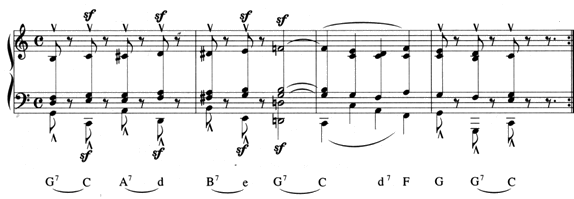
 | |

 
|
Secondary Dominants
Macro analysis simplifies the identification of secondary dominants
just as it does for finding modulations. By including the letter names of the
chords it is easier to identify changes in the diatonic harmonies. A secondary
dominant is like a miniature modulation; for just an instant, the harmony moves
out of the diatonic chords of the key.
Follow the same analysis steps as already described for nondominant
seventh chords:
-
Complete the letter analysis first.
Beethoven Sonata Op. 14 no. 2, Andante, m. 16-19

-
Identify letter names that represent non-diatonic harmonies.
Beethoven Sonata Op. 14 no. 2, Andante, m. 16-19

-
Complete slurs, roman numerals, and inversions.
Beethoven Sonata Op. 14 no. 2, Andante, m. 16-19

|



